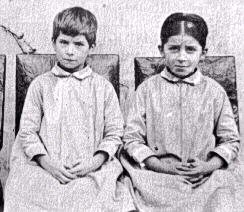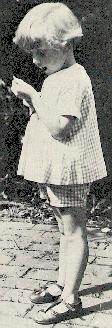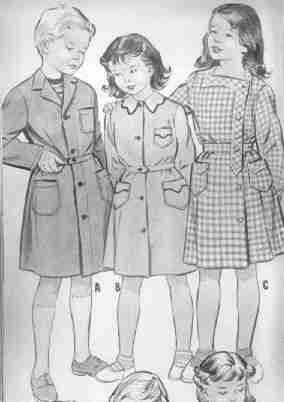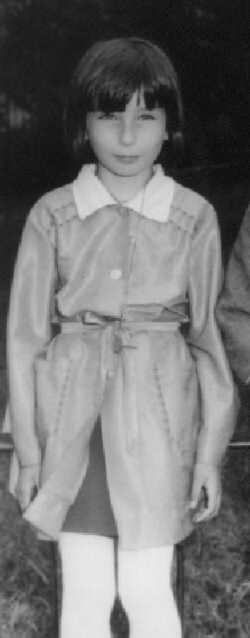
Smocks: National Styles

Figure 1.--Some smocks in the late-19th and early-20th century were worn quite long. Most were back buttoning. The children here are unidentified, but are probably European. Smocks were most common in Europe, but were worn in other countries as well.
|
|
Smocks were particularly popular on the Continent. Children in several countries wore smocks--mostly at school. Countries that required smocks for school wear, such as France and Italy, greatly expamded the usage of smocks. Boys in several countries wore school smocks. Boy also wore smocks at home, but this was more variable. Many mothers saw them as useful garments to prtect clothes. Country practices varried widely. In England, they were mostly worn by younger boys before they went off to preparatory boarding school. In France, older boys might wear them. In Germany, they do not seerm to have been very popular. Social class factors were involved. In America, they were more common in affluent families than in working class families. Much was up to the preferences of individual mothers.
Latin America
Smocks were adopted by two Latin American countries, Uruguay and Argentina, with large Italian populations. The children there wear white smocks with blue bows. Smock styles were originally back buttoning, but now the boys' smocks button at the front.
Argentina
HBC has no indication that Argentine boys commonly wore smocks. Smocks were worn by doctors and sometimes nurses, and aprons (although darker ones) were used by manual workers and typists. Although school children commonly wore white smocks. Virtually all the smovk impages in our archive are school smocks. Few boys appear to have worn smocks at home, even after school. Perhaps some of the chilodren of Italian immigrants may have worn smocks. The school children's attire was quite distinctive. An Argentine contributor to HBC reports that one lead he hopes to follow is to confirm that smocks were used in orphanages by the end of the 19th century. But he has found little evidence yet. He reports, "I will need to go back to Buenos Aires and see photos and descriptions of orphans to see what they wore and if their outfits were similar to the ones later adopted at public schools. I suspect they were different, and were more in line with the coats used in charity schools in England and France."
Jamaica is not a country that is normally known for boys wearing smocks. They are not widely worn for school as British style school uniforms are common, nor are they worn at home for play. Boys at the turn of the century were dressed more more voluminously than is the case today. Images show that English boys living in Jamaica might wear a smock over their clothes and long stockings as a form of play clothes.
America, North
Canada
HBC has wondered just how influential French fashions were in Canada, especially amomh French Canadians. As far as HBC can determine, French Canadian boys never wore smocks at home or at school as was common for French boys. A HBC reader has done some research on the topic. His efforts to search for information on smocks ("tablier") in Canada has only yielded information on girls wearing smocks. He concludes that the French style of school smocks was apparently not imported to Quebec. In fact, HBC has noted very little French influence on Quebec boys' fashions.
Smocks are a loose, lightweight overgarment worn to protect the clothing while working. The smock was not initially a child's garment, but rather a work garment widely worn by European farm workers and laborers in the early-19th Century, but this was not the case in America. We have not noted American farmers wearing agricultural smocks nor factory workers wearing smocks. Only later do we begin to see chikdren, mostly European children, wearing smocks. The popularity varied substantially from coyntry to country. While workers commonly wore smocks throyghout Europe, usage by cildren was much more varied. And in America seems particularly rare. European boys, especially on the Continent (especially France, Italy, Portugl, and Spain), have commonly been outfitted in smocks both at home and even more commonly for schoolwear. For some reason it seems most pronounced in Catholic southern Italy. We know less about how widely smocks were worn by boys in America. We know they were not work for school, but details on homewear is less available. As far as we can tell, American trends see more like Protestant northern Europe, understandablt becaise until the late-19th century, America was a largely Protestant country. We have been able to acquire relatively little information on smocks in America. Available images suggest that some American boys were dressed in smocks during the late-19th century, but not very many. A mother might dress her entire family, boys and girls in identical smocks. The back buttoning styles were generally chosen. This appears most common in wealthy families. After World War I it became even less common for boys to wear smocks. They were not popular with American boys. The few American boys who still wore smocks were was mostly boys being raised in wealthy families, but even this had mostly disappeared in the 1940s.
Asia
We have little information about Japanese smocks. As far as we can tell, few Japanese boys have worn smocks. The only photograph we have found has been a Japanese boy, probably about 1930 wearing what looks like a smock. The time line here is relatively narrow because until after Wotld War I, Japanese boys mostly wore traditional clothes. The major exception here appears to be schoolwear. We see some modern pre-school children wearing smocks. This appears to be fairly common in pre-schools. We are not sure about the chronology here. We have yet to see boys wearing smocks, however, in primary school.
Europe
Smocks were most commonly worn in Europe, but were worn by children in other regions as well. They were most commonly worn as a school garment, but not exclusively. The smock was used as a practical, protective garment at a time that laundry was a time consuming, labor intensive activity and clothes were more expensive in relative terms than is the case today. Fior school the smock was not only opractical, but helped to cover the the the clothing differences of children from different soicial classes. This was a factor not at play in the smocks worn as a play garment outsude of school. There were also social class cnnotations. Both boys and girls wore them, but there were different age conventions. Usage varies widely from country to country. They seem to have been especially popular in Belgium, France, Italy, and Spain. They seem most common in the late-19th and early-20th century.
HBC has no information on Austrian smocks. Austria was not a country that we have generally associated with smocks. We had assumed that they wer no commonly worn there, but in fact hav no actual information. One HBC reader has submitted a photograph of an Austrian boy wearing a rather short smock. It looks to have been taken some time after World War II, but the photograph is undated.
Belgium
Belgian boys commonly wore school smocks similar to the styles worn in France. They were
also common institutional wear. We know that school smocks were widely worn in Belgium, although HBC does not know to what extent they were required. They were also worn in orphanages. There may have been regional differences in Belgium. Smocks may have been more common in French-speaking Walonia than Dutch speaking Flanders. Smocks were reportedly also worn at home, by both boys and girls, but HBC has little information about this.
Czechoslovakia no longer exists having broken up into the Czech Republic and Slovakia in 199?. We have very little information on Czech boys' clothes at this time. We believe that Czech styles were heavily influenced by Austrian and German clothing styles. We have few Czech images, but do note that a few boys did wear smocks at home. These do not appear to be school smocks. We do not know how common this was in Czeslovakia or what the fashion influence was. We also note a Sudeten German boy in Czecoslovakia during the 1930s wearing smocks. The material was a rather Scottish plaid, but smocks were not commonly wiorn in Scotland. This appears to be more of a Czech than German dashion influence as smocks were not commonly worn in Germany.
Photographs of Prince Frederick (future Frederick IX) show him playing croquet in a white dress and smock in 1904. This is an interesting image because European royalty was not often photographed in smocks. HBC is not sure whether this was because princes did not commonly wear smocks or because they were considered to informal a garment in which to be photographed. HBC is unsure to what extent other Dutch boys from more humble circumstances wore smocks. We note that the children of famed phyicist Neils Bohr wore smocks in the 1920s. They may be school smocks, but we are not sure about that. We note his second son wearing a pinafore-type smock in 1923.

Figure 2.--Christopher Milne of Winnie the Poo fame wore summer smocks until he began boarding school a 8 years old. He was teased by the other boys for being Christopher Robin.
|
|
Home and school smocks for boys were never as popular in the English speaking countries as they proved to be on the Continent. I am not sure when mothers began dressing English boys in smocks. A variety of images show, however, that smocks and pinafores were
worn by boys in the late 19th Century. Artist like Helen Allingham provide some charming images for us. I am not yet sure, however,
how common it was and what age boy would wear smocks and pinafores.
A few British schools required smocks for very young children, even
into the 1980s, but that was an anomaly. Dressing boys in smocks at home and for playing outside was known in England as late as the 1920s and 30s. Boys
until they reached 8 and were ready for their preparatory school might be
dressed in smocks, especially during the summer for play. Chistopher
Milne, who served as his father's prototype for Christopher Robbin of Winnie the Poo fame, was
dressed in gingham smocks until he had passed his 8th birthday. This was, however, unusual. When he went off to his boarding school, the other boys teased him for being Christopher Robin and wearing smocks as they had all read the Winnie the Poo books and seen the drawings. Some progressive schools in Britain appear to have used smocks and sandals as a school uniform. In H.G. Wells's novel about education, Joan and Peter, he describes the children going to one of the "barefoot schools" supported by the artistically-inclined, "progressive" middle class. It turns out from the text, however, that the children were not actually barefoot. They wore the liberated dress of the period: smocks and sandals as illustrated in the Shephard drawings of Christopher Robin a decade later.

Figure 3.--This 1952 French advertisement shows school smock styles for boys and girls.
|
|
Smocks are probably more associated with France than any other single country. Smocks were worn by French boys during the late 19th and early 20th Century. It was most common for younger boys still in dresses to wear them, but some older boys wearing bloomer like knickers also wore them, sometimes boys as old as 8 or 9 years of age. They were worn as play clothes--often around the house, but less commonly as dress up clothes. French school smock became a tradition for several generations of French school boys. The smocks were introduced by the new Government of the Third Republic in the 1870s as a way of reducing class differences. Earlier in the century, smocks in Europe were more associated with work clothes, much as overalls in America. But the same factors which eventually led to children wearing overalls induced mothers to adopt smocks. In France, the use of the smock as a children's garment became quite widespread after they were adoopted as school wear. The school smock (black, blue , or grey smocks) became the common dress of French school boys well before the turn of
the Century. In the days in which boys wrote with pen nubs dipped in an ink well, ink stained fingers and clothes were a common result. Thus black and blue smocks were a practical solution to protect clothes. French boys, perhaps as the school smock was so common, also wore smocks at home more than boys in most other European countries. French boys commonly wore smocks at home. This was particularly common
in the late 19th and early 20th Centuries. Little boys still in dresses
wore smocks, but also boys in bloomer like knockers and kneepants as
well. During this period, once a boy was allowed to wear long pants,
he no longer wore smocks.
Smocks do not appear to have been very popular in Germany, although admittedly I have little information at this time. HBC has noted some younger German boys wearing smocks, most to school during the late 19th and early 20th century. After World War I (1914-18) smocks virtually disappeared as fashions associated with the English and French became unpopular. After the NAZIs seized power in 1933, smocks were no longer seen in Germany.
I am not sure at this time how common smocks were in Greece. HBC at this time has no evidence that they were widely worn, but our historical information on Greece is stull very limited. We do know, however, that they were extensively worn as a school garment. Many Greek school children did wear school smocks. They were required at schools as a nation-wide rule for many years and worn in the national colors--blue and white. The smocks were blue and worn with white collars. A Greek reader reports school children in the 1950s wearing blue smocks with wide white collars. One Greek reader describes wearing a smock at a private school in the 1980s. Wearing smocks to school, however, for the most part ended when the Greek Government banned school uniforms in 1982.

Figure 4.--While HBC has little information on the extent to which smocks were worn in Hungary, we do know that beginning in the 1960s that they were worn as a kind of school uniform.
|
|
HBC at this time has little information about Hungarian boys wearing smocks. We do not know to what extent the smock was worn in Hungary. We do have some information about smocks use as school uniforms beginning in the 1960s when the government mandated them as a kind of school uniform. This continued through the 1990s for boys including older boys in secondary school.
Smocks were also commonly worn by Italian school children.
The colors varied some what, but the style usually included a large
white collar and colorful bow. Quite a number of Italian schoolchildren, boys and girls still wear them. Many schools have different colors or styles for the boys and girls. Other schools have boys and girls in identical colors and styles. Smocks with wide white collars and floppy bows were especially popular in Italy. Often the girls continue to wear back buttoning smocks while boys wear front buttoning ones. Some schools, however, continue to have both boys and girls wear the back buttoning ones. Virtually all Italian children once wore school smocks, but their popularity has declined in recent years.
HBC has little information about Dutch boys wearing smocks. We do not believe that they were as common as in some neighboring Belgium. Some images from the turn of the century do show Dutch boys wearing pinafore-like smocks. A Dutch source reports that boys did wear smocks, but not as a part of the school clothing like in France/Spain/Italy. Smocks are called "boerenkiel" (kiel=smock for boeren=peasants) and were common in rural areas until about the mid-1930s.
Poland
We do not yet have any information on smocks in Poland and the extent that they were worn by children. We do note that Communists authorities after World War II adopted smocks or fartuszki as they were called for school wear. They were worn by boys and girls in both primary and secondary school.
Various terms were used for smock in Portuguese, including guarda-pů, avental, bata, and jaleco. We are mot sure at this time about the usage of these different terms. Smocks were not just worn by children, but by factory workers and shop workers, commonly women. The different Portuguese terms probably involve the different terms. We do not have a large Portuguese archive and thus cannot make any substantial assessment of smock trends in Portugal at this time. We have found very few images of Portuguese children wearing smocks, but this seems to reflect our small archive. We can not yet say how common they were. We note one image of boys wearing smocks while celebrating Christmas (1910s). It is not clear if the boys commonly wore smocks for play or if they were wearing their school smoks for some reason. They do not appear to be uniform smocks. We think that smocks were commonly worn to school in the 20th century. They are still worn at sone schools, mostly porivate schools. Other images show boys wearing school smocks, we think in 2000s.
Spain
Smocks were worn by Spanish boys. Many elementary schools do seem to have required
them, but I do not know if there was a national rule. There appears to have been some regional differences, with destinctive styles in Catalonia. One Spanish contributor reports that boys in a small town near Barcelona wear a front buttoning smock with a brown
belt. Normally the whole of Cataluna wears the very same type at school, white with blue stipes and blue collar, pocket and cuffs. We still, however, have little information on Spanis smocks in general. We do have some information on school smocks.
Switzerland is a multi-cultural and linguistic country. Smocks were commonly worn by Swiss-Italian and Swiss-French boys, but less so than the Swiss-German boys. They were mostly worn to school. As far as boys clothing is concerned, the French speaking part of Switzerland was comparable to France. It was compulsory for boys to wear a smock until 9-10 in the years 1930-1960, about one third would then continue up to end of primary school
around 12 years. The style and colors of these smocks were left to the parents
discretion, there was no uniformity but a wide variety in mainly three styles: back buttoning, side buttoning, and a pinafore style.

Figure 6.--This Turkish movie showed boys wearing their school smocks.
|
|
Ulster
I do not have a great deal of information on Ulster, but suspectb that the clothing worn by the Ulster-English families was similar to that in England. I'm less sure about the Irish boys, especially the Catholics in rural areas. One well known Ulster boy who wore smocks was Field Marsahl Alexander whose family estate where he grew up was in Ulster.
Middle East
Children in Pallestine and many other Arab and other Middle Eastern countries (Iran
and Turkey) often wear smocks. They are mostly worn as school wear. I believe that
the style was primarily adopted as a result of French and Italian coloianl rule
and influence. Smocks in Middle Eastern countries were almost always worn with
long pants. The lighter colored smocks were most popular. The modesty inherent in this attire may in an acceptable style to Islamic fundamentalists--despite the European origins. Middle Eastern smocks appear to be mostly back buttoning styles,
Lebenon
Palestine
Syria
Turkish as other Middle-Eastern school children commonly wore school smocks. I think the smocks were almost always associated with school wear. We do not have many details on the styles involved or the extent to which individual schools dictated specific styles. Some images show that the smocks might be worn with large Peter Pan collars. Turkish boys almost always wore their smocks with long trousers. The turkish smocks also seem rather short.
Oceania
Australia
Australian boys have not commonly worn smocks. Some boys in the late 19th and early 20th century might have worn them as was the case in England. Presumably this would have been pre-school age boys. HBC does not, however, have any details on this and it appears to have been even less common than in England. An Australian official, His Excellency, The Honourable Sir James Gobbo, who emigrated from Italy remembers his first school experiences. He delivered an address on diversity as opposed to conformity. He explained. "I had early experiences of that; As you heard I came back to this country when I was about seven, having lived most of my childhood in Italy and I came not knowing any English, and I was delivered into the tender mercies of Errol Street State School in North Melbourne at that age. That would have been difficult enough, but my dearly beloved mother sent me to school in the gear that Italian children used to wear at that age. The practice for them was to go to school in smocks; large, checked smocks with big blue bows for boys and pink bows for girls. Well, you can imagine the reception I got when I went into the school yard at Errol Street State School dressed in this gear. I thought that I would never be able to venture into a classroom or a school yard again, but I survived that, with some difficulty." HBC is not sure just when this may have occured, but would guess this would have been the late 1930s or late 1940s. (Immigration would have been closed during the World War II years (1939-45).
HBC has no information on the extent to which boys wore smocks in New Zealand. Available photographic images, however, do suggest that in the early 2oth century that some boys did indeed wear smocks. We suspect that it was not as common as say France, but instead followed the English pattern where smocks were worn, perhaps more commonly by boys from affluent families or families involved or influenced by continental European culture.
We have noted some images of boys in smocks which are not identified. We have some idea about the countries involved, but often can not be positive unless there is some provinance associated with the image. Hopefully reader will have some insights to help idetifythese images.
Personal Experiences
Only a few personal accounts are available concerning boys who wore smocks as children,
most are European accounts.
HBC

Navigate the Boys' Historical Clothing Smock-related pages:
[Return to the Main smock page]
[Pinafores]
[Fauntleroy suits]
[Fauntleroy dresses]
[Sailor hats]
[Park outings]
[French page]
[Renoir page]
[School smocks]
Navigate the Boys' Historical Clothing Web Site:
[Introduction]
[Activities]
[Biographies]
[Chronology]
[Clothing styles]
[Countries]
[Bibliographies]
[Contributions]
[FAQs]
[Glossary]
[Images]
[Links]
[Registration]
[Tools]
[Boys' Clothing Home]
Created: February 20, 1999
Spell checked: August 2, 1999
Last updated: 4:21 AM 9/7/2018







